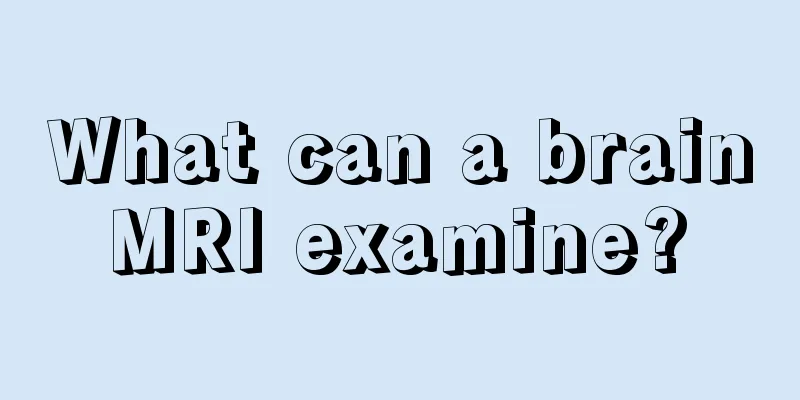What can a brain MRI examine?

|
With the rapid development of modern medical technology, people have invented many advanced detection methods to detect diseases in the body in a timely manner and lay a solid foundation for treatment. For example, using brain MRI technology to conduct physical examinations is a very advanced method and has been favored by a large number of healthy people. This technology can detect major disease problems. Let’s take a look at what brain MRI can check? The full name of NMR is Nuclear Magnetic Resonance Imaging (NMRI for short). Many people wonder why they need to do an MRI after a brain CT scan? This is because cerebral palsy is a complex disease. Due to the limitations of brain CT, sometimes brain CT cannot diagnose brain abnormalities. At the same time, many parents are not reassured about the test results after their children have had a brain CT scan. In order to further diagnose their children's condition, they will give their children an MRI to help diagnose the condition. Therefore, it is very necessary to understand the significance of brain MRI for cerebral palsy. MRI is more accurate than brain CT. MRI of the head is more sensitive than CT, and has the characteristics of multi-directional sectioning and multi-parameter imaging. It can more accurately display the location, size and histological characteristics of the lesion. It is the preferred method for discovering lesions in the internal brain structure, but it is relatively expensive. According to relevant surveys, the abnormal rate of CT examination is 59.1%. For head examination, MRI examination is more specific. MRI has a sensitivity of 95% in showing cerebral palsy lesions. The following are some of the more common cerebral palsy findings from brain MRI examinations: Brain atrophy, white matter lesions (such as PVL), encephalomalacia (multicystic), basal ganglia damage, delayed myelination, unilateral brain atrophy, cerebellar atrophy, ventricular enlargement, congenital malformations, and mixed lesions are common MRI morphological abnormalities in children with cerebral palsy. (1) MRI manifestations of cerebral palsy caused by PVL: (2) White matter reduction mainly occurs in the trigone, body and centrum semiovale of the lateral ventricle; (3) Abnormal white matter signals mainly occur in the trigone, body and centrum semiovale of the lateral ventricle; (4) The cerebral ventricles are enlarged and deformed; the cerebral sulci and cisterns are enlarged and widened; (5) Abnormalities of the corpus callosum. (6) Other MRI abnormalities include cortical atrophy and softening and basal ganglia degeneration. |
<<: What are the causes of non-exercise muscle soreness?
>>: How to control your heart rate during aerobic exercise to lose weight?
Recommend
Arterial calcification
Arterial calcification is a common disease among ...
The schedule of the top student
There are many top students in our lives. For the...
How about taking Chinese medicine if you have uterine cancer
Endometrial cancer is a very common malignant tum...
Cancer may be "fed" by your own mouth! Come and have a look
We often hear that illness comes from the mouth, ...
Large red spots suddenly appeared on the body
Large patches of red spots suddenly appear on the...
Taking vitamin E can make your breasts bigger
In real life, many women have the idea of breas...
What are the differences between the symptoms of breast cancer and fibroids
The fibroids here usually refer to breast fibroad...
How long can you live after surgery for malignant melanoma
How long a patient with malignant melanoma can li...
Can indigestion cause abdominal pain? What are the symptoms?
There are many causes of abdominal pain. Some pat...
My teeth are very yellow and I can't whiten them no matter how hard I try
In our current life, we all want a bright and per...
What should we pay attention to when having perianal abscess
In addition to paying attention to and following ...
Can Panax notoginseng powder beautify and remove freckles?
Panax notoginseng is a very common medicine in li...
Can I have my wisdom teeth removed in the afternoon?
Tooth extraction is something that many people wi...
Is the back-picking method for hemorrhoids harmful? How to do it? ?
Hemorrhoids are very common in life and are also ...
What medicine is used for metastatic lymphoma
For patients with malignant lymphoma, treatment i...









